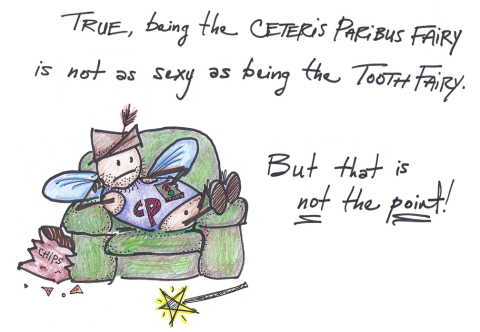Ceteris paribus — an alibi fairy When applying deductivist thinking to economics, mainstream economists usually set up ‘as if’ models based on a set of tight axiomatic assumptions from which consistent and precise inferences are made. The beauty of this procedure is of course that if the axiomatic premises are true, the conclusions necessarily follow. The snag is that if the models are to be relevant, we also have to argue that their precision and rigour still holds when they are applied to real-world situations. They often don’t. When addressing real economies, the idealizations necessary for the deductivist machinery to work — as e. g. IS-LM and DSGE models — simply don’t hold. Defending his IS-LMism from the critique put forward by e. g. Hyman Minsky and yours truly, Paul Krugman writes: When people like me use something like IS-LM, we’re not imagining that the IS curve is fixed in position for ever after. It’s a ceteris paribus thing, just like supply and demand.
Topics:
Lars Pålsson Syll considers the following as important: Theory of Science & Methodology
This could be interesting, too:
Lars Pålsson Syll writes Kausalitet — en crash course
Lars Pålsson Syll writes Randomization and causal claims
Lars Pålsson Syll writes Race and sex as causes
Lars Pålsson Syll writes Randomization — a philosophical device gone astray
Ceteris paribus — an alibi fairy
When applying deductivist thinking to economics, mainstream economists usually set up ‘as if’ models based on a set of tight axiomatic assumptions from which consistent and precise inferences are made. The beauty of this procedure is of course that if the axiomatic premises are true, the conclusions necessarily follow. The snag is that if the models are to be relevant, we also have to argue that their precision and rigour still holds when they are applied to real-world situations. They often don’t. When addressing real economies, the idealizations necessary for the deductivist machinery to work — as e. g. IS-LM and DSGE models — simply don’t hold.
Defending his IS-LMism from the critique put forward by e. g. Hyman Minsky and yours truly, Paul Krugman writes:
When people like me use something like IS-LM, we’re not imagining that the IS curve is fixed in position for ever after. It’s a ceteris paribus thing, just like supply and demand.
But that is actually just another major problem with the Hicksian construction!
As Hans Albert noticed more than fifty years ago:
The law of demand … is usually tagged with a clause that entails numerous interpretation problems: the ceteris paribus clause … The ceteris paribus clause is not a relatively insignificant addition, which might be ignored … The clause produces something of an absolute alibi, since, for every apparently deviating behavior, some altered factors can be made responsible. This makes the statement untestable, and its informational content decreases to zero.
This is a critique rehearsed by John Earman et al. in a special issue of Erkenntnis on the ceteris paribus assumption, concluding that it is bad to admit ceteris paribus laws at all in science, since they are untestable:
In order for a hypothesis to be testable, it must lead us to some prediction. The prediction may be statistical in character, and in general it will depend on a set of auxiliary hypotheses. Even when these important qualifications have been added, CP law statements still fail to make any testable predictions. Consider the putative law that CP, all Fs are Gs. The information that x is an F, together with any auxiliary hypotheses you like, fails to entail that x is a G, or even to entail that with probability p, x is a G. For, even given this information, other things could fail to be equal, and we are not even given a way of estimating the probability that they so fail. Two qualifications have to be made. First, our claim is true only if the auxiliary hypotheses don’t entail the prediction all by themselves, in which case the CP law is inessential to the prediction and doesn’t get tested by a check of that prediction. Second, our claim is true only if none of the auxiliary hypotheses is the hypothesis that “other things are equal”, or “there are no interferences”. What if the auxiliaries do include the claim that other things are equal? Then either this auxiliary can be stated in a form that allows us to check whether it is true, or it can’t. If it can, then the original CP law can be turned into a strict law by substituting the testable auxiliary for the CP clause. If it can’t, then the prediction relies on an auxiliary hypothesis that cannot be tested itself. But it is generally, and rightly, presumed that auxiliary hypotheses must be testable in principle if they are to be used in an honest test. Hence, we can’t rely on a putative CP law to make any predictions about what will be observed, or about the probability that something will be observed. If we can’t do that, then it seems that we can’t subject the putative CP law to any kind of empirical test.
The conclusion from the massive critique should be obvious.
Ditch the ceteris paribus fairy!
